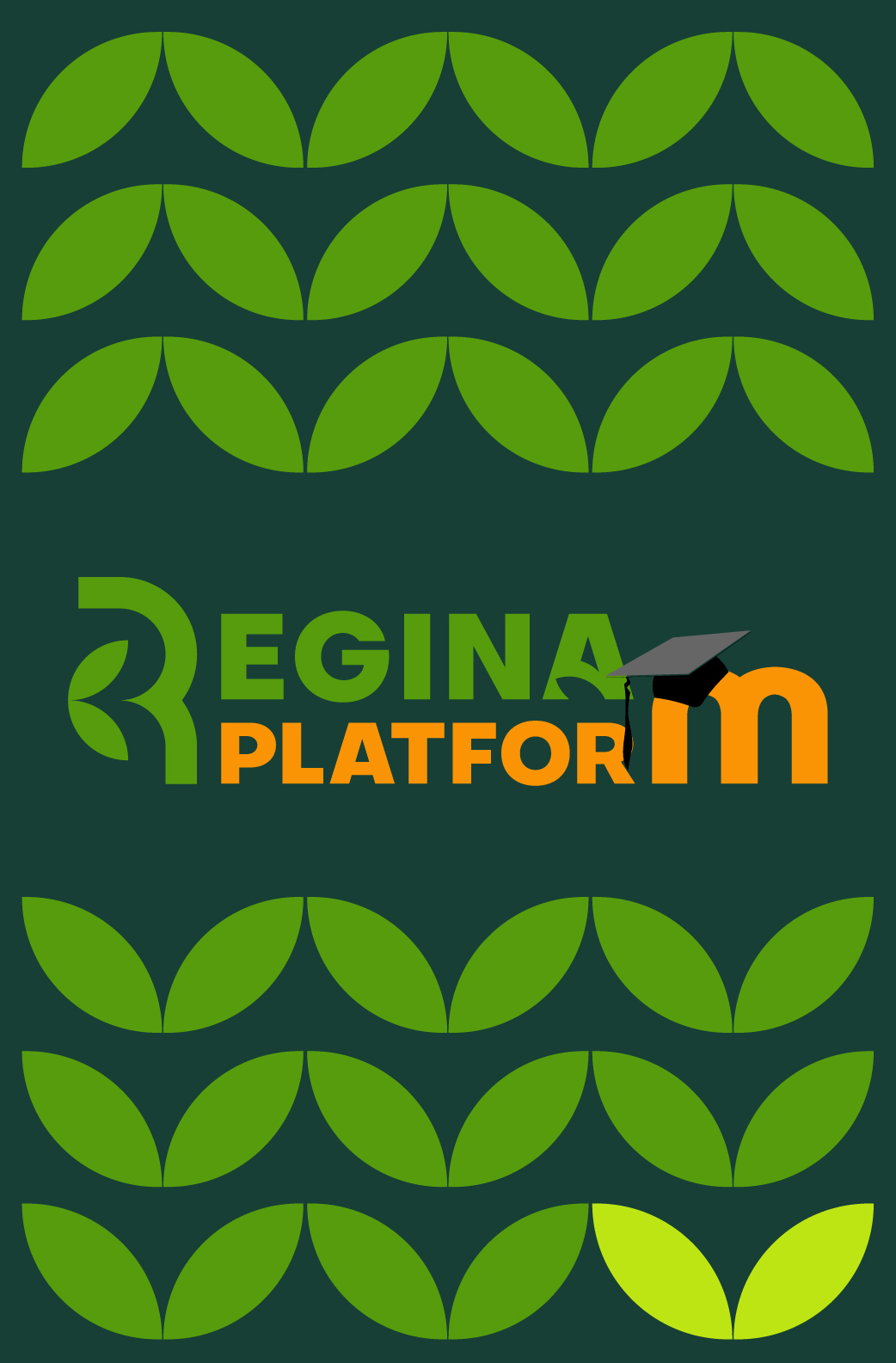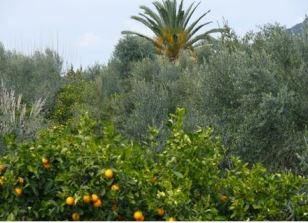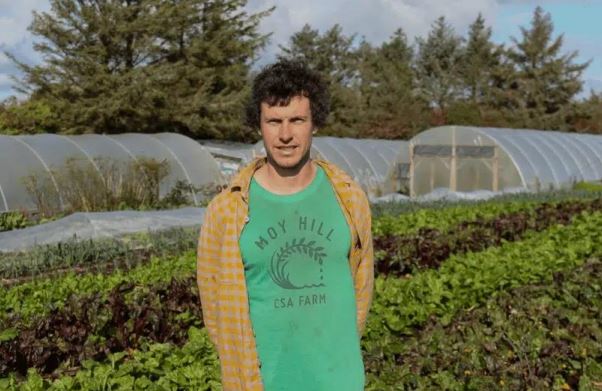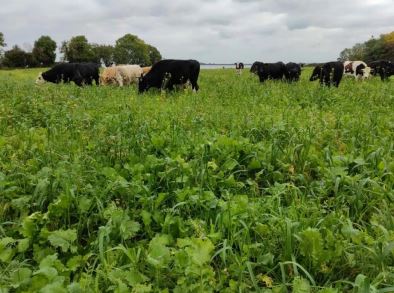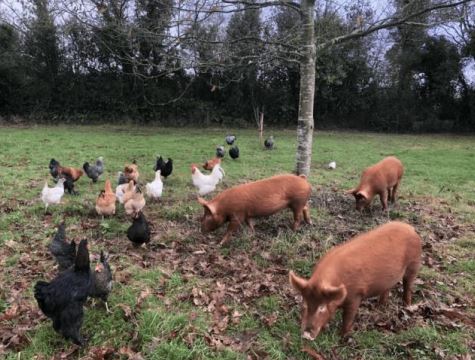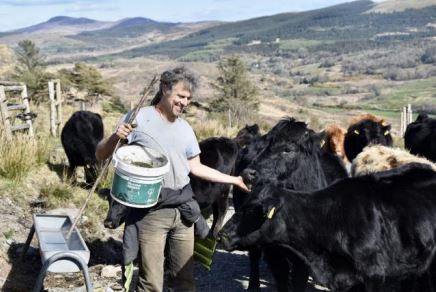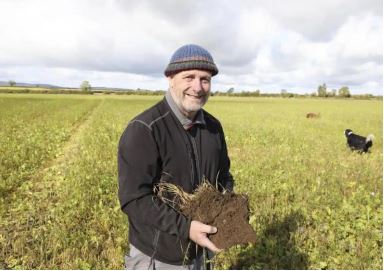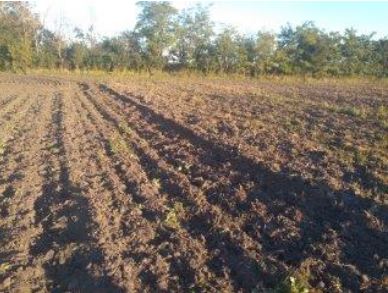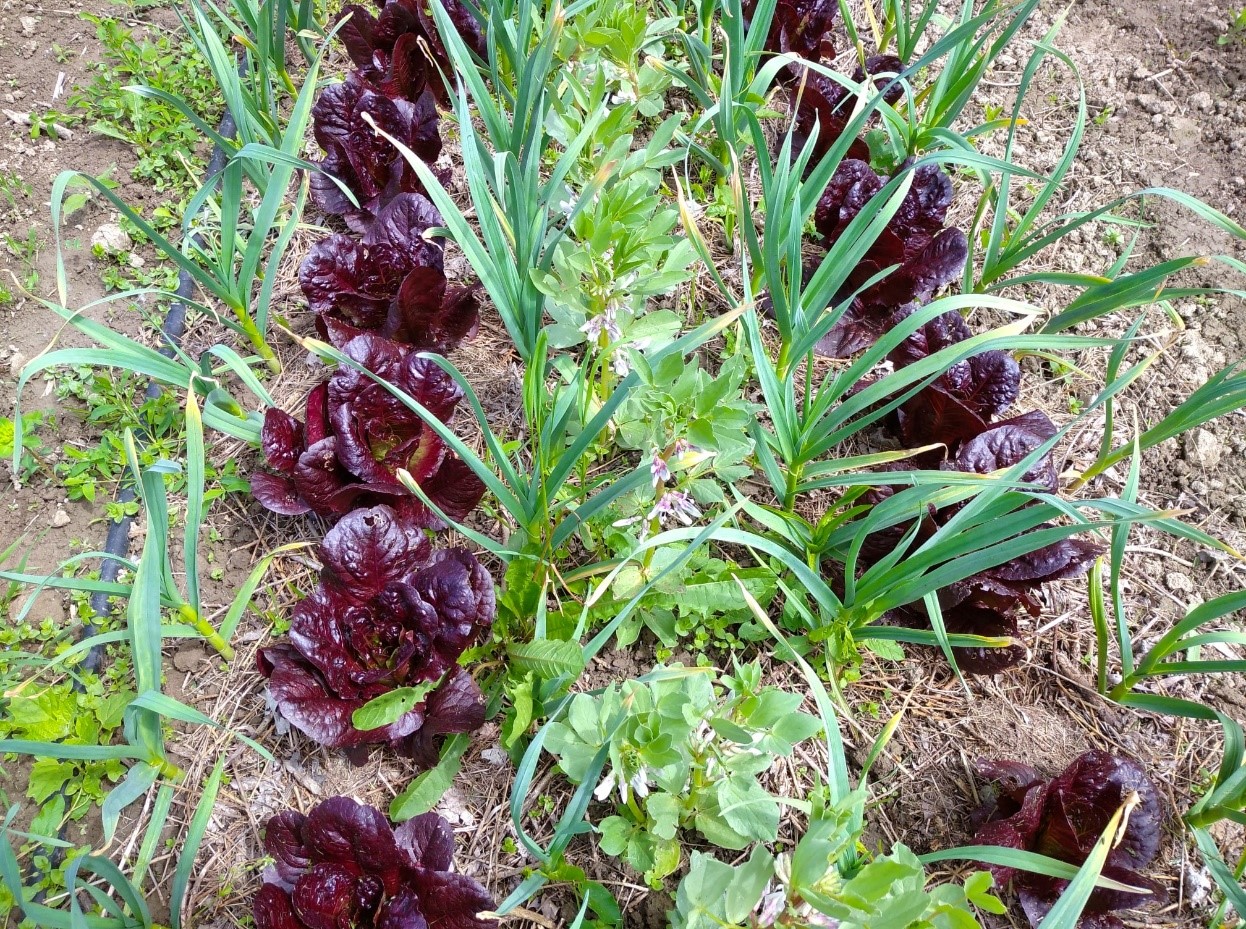Categories
Biodiversity
The Southern Lights Pilot Farm
Success Story
Since 1985, the farm has been implementing advanced organic farming, applying practices such as green fertilisation, fragmentation of branches and introduction into the soil, and increasing biodiversity. The next generation of the family-owned farm decided to go a step further, when they noticed that in their farm the forest started to grow while in the surrounding mountains the forest did not return 11 years after the wildfires that had destroyed it. Sheila, the daughter of the original farmer who had decided to apply advanced organic farming since 1985, together with other family members, started researching into the concept of regenerative agriculture and the agroforestry principles and methods, receiving training abroad, and started to implement RA methods on the farm systematically 7 years ago. Today she is sharing the benefits of the transition to RA, ranging from working on a farm with increased biodiversity and the therapeutic effects this has, the financial security that comes from an increased farm resilience, and the new commercial opportunities available in other sectors (e.g. tourism), to the personal satisfaction for contributing to the fight against climate change and the sense of belonging to a wider network of like-minded persons. Southern Lights participates as a partner in an important project to promote Regenerative Agriculture in Greece. The project was launched in 2021 in order to bring Regenerative Agriculture to Greece and has created 6 pilot farms in different areas of Greece and with different crops, while offering through its website www.regenerativefarminggreece.org important information and educational material for Regenerative Agriculture.
Labels: Greece, organic, vegetables/fruits, agroforestry, biodiversity
Moy Hill Farm
Success Story
Introduction to Moy Hill Farm
Fergal and Sally run an 80-acre mixed regenerative farm on the west coast of Ireland. Fergal grew up on an organic market garden farm in Mayo where he learned about the importance of soil health and farming with nature. After a few years of travelling and surfing around the world, Fergal returned and started his own farm near the surfing town of Lahinch in County Clare, where he now lives with his young family.
Moy Hill Farm contains a mixture of livestock – cows, sheep and hens, and grows about 25 different crops in their “No Dig” Market Garden. They sell a variety of fresh produce at markets and to local restaurants.
Regenerative Agriculture Training
Fergal and Sally began farming regeneratively in 2017 after learning about the methods in a Holistic Management course provided by the Savory Institute, an agricultural research organisation with hubs across the world. Here, they learned how to sustainably manage livestock and how to plan the year ahead to ensure fresh pasture year-round, reducing feed and fertiliser costs. Since then, Fergal has engaged in many trainings, such as a regenerative farming course run by expert Richard Perkins and the Irish National Organic Training Skillnet. He said it is inspiring to learn about farmers from around the world engaging in regenerative agriculture through these trainings and events.
Using Livestock to Regenerate the Land
Fergal described how animals are key for regenerating large areas of land. He views his way of farming as managing ecosystems, protecting and enhancing habitats, and focusing on diversity. Fergal manages his animals so that they benefit, not harm, the environment around them.
Livestock are put into small paddocks and moved daily onto fresh pasture. This rotation cycle, called “mob grazing”, allows for areas of grassland to rest and recover in the periods where they are stockless. Plants are left to “fully express themselves, which allows for the other habitants of the farm, such as insects and birds, to thrive as a result. Fergal believes that he can regenerate hundreds of acres of land with the help of livestock (cows, sheep, poultry) and regenerative management practices.
Regenerative Verification
Every year, Moy Hill farm get an EOV “Ecological Outcome Verification” assessment on their land which verifies that their soils are getting healthier. The EOV surveyors monitor every field on the farm to ensure all environmental indexes are going up. Fergal described how this EOV verification is a simple way of holding regenerative farmers accountable, as it will prove whether they are regenerating their land and making a positive impact.
No Dig Market Garden
Fergal and Sally follow the regenerative practise of minimum disturbance of the soil. Their market garden is not tilled or dug, in an effort to protect the soil’s structure and biodiversity. Up to 25 different crops are grown on their market garden such as salads, kale, beetroot, beans, tomatoes, squash, courgettes, peas, turnips, leeks, onions, and garlic. Their salads are the best seller as local restaurants and shops are in constant demand for fresh, local lettuce.
An Ode to the Past
Fergal described how the way he farms now, is very similar to how traditional farms in Ireland were managed many years ago. Most farms used to have a vegetable garden, poultry, and it was common to have a mixture of livestock, whilst sewing native trees and orchards. Regenerative Agriculture is therefore, as Fergal described, not a “new” concept. It is all about farming in a way that makes sense for the local environment and for the farmers themselves. Fergal and his family benefit from fresh produce and an outdoor lifestyle that is in tune with nature. He describes farming this way as a “labour of love” and “being part of a bigger picture”, whilst also creating a healthy life for himself and his young family. The work of regenerative agriculture never stops, but this makes for an exciting challenge for Fergal.
An Affirming Experience – Farming with Intention
Fergal and Sally believe in “farming with intention”, and that diversity across their farm is key to its health and long-term success. While they are not receiving any financial support to farm regeneratively, indeed the training and EOV certification is costing them money, they are able to grow high quality food and thus market their products at a higher price. Fergal noted how he has been experiencing the ecosystem on his land ‘thrive’ since implementing RA practices, and he spoke about how this is an affirming experience for himself and his family.
LABELS: Ireland, Livestock, Organic, Vegetables/fruits, Green Fertilisation, agroforestry, biodiversity
Mervyn Auchmuty
Success Story
Farming as a Way of Life
Growing up on the family farm, farming for Mervyn Auchmuty has always been his way of life; “I never became a farmer, I was always one”. Now, Mervyn and his father Robert are farming together on their picturesque 400-acre arable (tillage) and mixed livestock farm in County Roscommon.
Minimum Tillage (Min Till)
Mervyn was first introduced to the idea of ‘Regenerative Agriculture’ in 2013, through learning the concept of “minimum tillage” or “min till” (minimum disruption of the soil). The Auchmuty’s land is stoney and therefore difficult to plough, taking many man hours to do so. Removing ploughing from their workload meant less hours ploughing, picking stones, burning diesel, and preparing cropland. The advantages of ‘min till’ were clear for their land. For many, the idea of not ploughing or tilling arable land seems ludicrous, but Mervyn managed to convince his father Robert that it could be a good idea.
Strip-Tilling
And so, the father-and-son duo removed the process of ploughing their soil, and they invested in a “Strip-Till Drill” through the aid of a TAMS (Targeted Agriculture Modernisation Schemes) grant. This Strip-Till allowed the pair to greatly reduce the amount of soil being tilled, only tilling the strips of land where crops were being sown. Mervyn explained the importance of minimum disturbance to the soil for keeping the soil microbes alive, which enhances the nutrient quality of the soil over time. Now the pair also use a “Direct Drill”, which does exactly what it says on the tin; directly drilling the crops into the soil without tilling at all.
Cover Crops
Another benefit to ‘Min Till’ is that most of the soil can remain covered with plants. Mervyn explained how the soil can degrade when there are no plants to cover it; due to factors such as the reduced ability for the soil to absorb carbon and the exposure of the soil to the elements (Sun, Wind, Rain). Therefore, cover crops play a crucial role in the period after crops have been harvested, to cover the bare soil with temporary plants to promote photosynthesis, carbon sequestration and good soil health. The use of cover crops is a practice which many tillage farmers do not observe, yet this changing, increased understanding of the benefits of cover crops through research, and the introduction of government incentives for cover crops are slowly increasing the use of this practice in Ireland.
Improved Root Structure
Mervyn has noticed how the root structure of his crops have improved since he began trialling Regenerative Agriculture practices back in 2013. Plant roots play a vital part in aerating the soil; allowing for better water absorption and providing vital nutrients to the soil.
Natural Fertilisers
The Auchmutys create natural compost with farmyard manure. This process for many farms is now a forgotten practice, as slurry is a more popular modern technique, even though it emits much higher amounts of greenhouse gases (methane, carbon dioxide) and toxic fumes (ammonia and hydrogen sulphide). The creation of natural compost calls for extra time and man hours from the farmers, but the natural benefits are clearly worth it for Mervyn and Robert.
Mervyn has experimented with seaweed and seed washes for naturally fertilising his cropland and seeds. Through his experimentation, he has found that treating seeds before planting leads to longer and stronger root systems and healthier soils.
Part of the Irish Regenerative Agriculture Community
In 2018, Mervyn joined the farmer-run regenerative agriculture group called “BASE Ireland”. Here, farmers share their experiences, ideas, and lessons of advice to other farmers trying out these alternative farming methods. The BASE (Biodiversity Agriculture Soil Environment) group allows farmers to educate each other, chat online, and host knowledge-sharing workshops.
As well as this, Mervyn has engaged in several NOTS (National Organic Training Skillnet) training courses and soil testing initiatives. He has learned a lot from videos on YouTube and through reading internet resources, and he does his part by sharing his knowledge and experience to other farmers through the BASE group.
Engaging in Regenerative Agriculture has kept Mervyn and his father Robert motivated on their farm. Each year, the duo trial new regenerative practices, which helps “keeps it interesting”. Mervyn hopes to continue to learn and trial at least one new regenerative agriculture practice each year.
LABELS: Ireland, Crop Production, Livestock, Green Fertilisation, Biodiversity, Biodynamic Agriculture, Crop Rotation, Min Till
John Mchugh
Success Story
John McHugh is a nature-friendly, registered organic farmer from Co. Laois, who inherited a 95-hectare farm from his parents in 2001. He has a modest herd of 60 dairy cows, along with a small beef herd, hens and pigs, whom he frequently integrates together as seen in the image below.
The Beginning of John’s Regenerative Journey
In 2014, John needed a change. He wanted to be free from debt and for his farming to become more resilient; both economically and environmentally. He no longer wanted to “blindly follow advice”, and he was motivated to discover less intensive farming methods. So, he began the gradual process of reducing his herd size and has gone from a herd of 160 in 2014 to 60 in 2023.
John believes that there is not much space for nature in the conventional system due to the stringent rules and high costs. So, regenerative agriculture was an exciting opportunity for John to make a real change, on his own terms. John believes that dairy farmers can be too heavily focused on trying to have as many cows as possible, while maximizing output. He explained how this can be a vicious cycle of higher costs and inputs, as he came to realise from his many years of conventional farming.
100% Forage Based Feed
Now, after farming more regeneratively for almost 9 years, John’s land has grown incredibly resilient. For example, John has not been feeding any grain feed to his cows and other cattle on the farm since 2020, all animals are 100% forage fed (predominantly grass). His pastureland is plentiful, and he makes his own silage and hay for indoor feeding. John explained how his animals’ forage-based diet allows for the end products (meat and milk) to be richer in omega 3 fatty acids. Creating his own feed allows for a healthier, more cost-friendly, and generally more sustainable product as it is all produced on-farm through organic growing methods.
Keeping the Cattle Out Year-Round
Unlike most other Irish dairy farms who bring their cattle in for the winter, John can keep his cattle out year-round as his herd is small and his pasture is abundant and resilient to the Winter weather conditions. He puts this resilience down to his regenerative farming methods; with stronger soils and healthier plant growth. Of course, he mentions, if the weather becomes harsh then he will bring the cattle indoors, and indeed, his winter milking cows are kept indoors for ease.
Becoming Friends with Shrubs and Trees
John is engaging in the process of semi-rewilding areas of his land through engaging with Agroforestry and growing Scrubland. He keeps the cattle out of these areas until the land has matured enough for them to forage, as seen in the image below. Allowing his dairy cows to feed outside of grassland pasture is unique in the Irish dairy farming landscape.
John believes Regenerative Agriculture is “highly contextual”, and that farmers must find the practices that work for them, and their land. John holistically grazes his cattle on mature, diverse grassland. Paddocks are not over-grazed, and are given time to rest and regrow after grazing.
Welcoming in the Community
John has allocated a section of his farm for the community to keep small allotments and grow their own produce. This community farm is planted with a mixture of native trees and vegetables in the hopes of forming a Forest Garden with plentiful fruit and nut trees. For John, the community farm is not about profit, it’s about social exchange and people working together.
Biodiverse Pastureland
John has multispecies swards of a variety of native grasses and herbs that lead to his fields looking like colourful meadows in the Spring and Summer. He allows his grass to go to seed, which has exploded the biodiversity and greatly increased the number of pollinators.
Saying No to Chemical fertilizers
John believes that you can’t claim to be regenerative if you are using nitrogen or phosphorus fertilisers, as they undermine the carbon and natural diversity of our swards. Indeed, these fertilisers have been known to reduce soil biodiversity whilst leading to high levels of run-off and subsequent water pollution in Ireland. John noticed how when other farmers were struggling with drought and wet weather conditions nearby, his grass was continuously growing strong, and he believes this is due to improved water retention in his soil that has been enabled through his years of regenerative practices.
Quality Produce, Improved Animal & Financial Health & Continuous Improvement
John sells his dairy to a local organic yoghurt producer called Glenisk. While organic premiums were hit hard this year, he hopes to receive a higher price for his goods in the coming years. Through regenerative farming, John has found financial resilience, a reduced workload, huge improvement in his animals’ health, and more time to spend with his young family. John says that regenerative agriculture is a constant process, with continual tweaking and reassessments of practices necessary.
LABELS: Ireland, Livestock, Organic, Dairy, Green Fertilisation, Agroforestry, Biodiversity
Paul Moore Tillage (Arable) Farmer
Success Story
Paul Moore is a Tillage farmer near Midleton, Co. Cork. He farms 56 hectares, growing crops such as Malting Barley, Beans and Oilseed Rape, with a small herd of cattle. In 2017, Paul began experimenting with ‘Regenerative Agriculture’ practices to see if it would work for his type of farming, and for his land.
About one quarter of Paul Moore’s land is farmed regeneratively, and as he begins to learn the techniques and see improvements, he hopes to transition more of his farmland to Regenerative Agriculture. Regenerative Agriculture Practices that Paul uses include:
- Strip Tilling: Whereby only narrow strips of land are tilled (where the seeds get sewn), with the areas in-between left undisturbed. This method improves water drainage and enhances soil health, which can lead to higher crop yields.
- Wildlife Margins: Area surrounding fields that are left uncut for wildlife to flourish unharmed. Native flowers are excellent for the health of our native pollinators and natural biodiversity.
- Beetle Banks: These are wide strips of uncut land amongst tillage fields that create habitats for beetles that feed on the pests that attack crops. Natural pesticides, if you will!
Since starting Regenerative Agriculture practices, Paul has noticed an increased number of “helpful” insects on his land. These insects include Ladybirds and certain Beetles, which are natural predators to the Aphid. Aphids are pests on tillage farms that are usually killed with chemical pesticides. The Aphid population on Paul’s farm is kept low due to the predatory insects. Paul explains that his main issue with using no pesticides is having to deal with slugs! He is currently experimenting with different ways of combating slugs naturally.
Government schemes such as the old “GLAS” scheme (now evolved to the “ACRES” scheme) have allowed Paul to gain some financial support for the use of cover crops, a regenerative practice. Cover crops ensure that bare soil, which releases carbon into the atmosphere, is covered between harvest and resowing. By covering the soil with plants, photosynthesis absorbs carbon and creates nitrogen to feed the soil and reduce emissions. This process not only increases the health of the soil, but also the quality of the future crops. The longer Regenerative Agriculture is used, the more resilient the ecosystem becomes.
For Paul, the benefits of this style of farming have reduced his workload and input costs. The transition period to Regenerative Agriculture can produce lower yields for a couple years as it takes time to get the soil conditions right for sowing. However, Paul thinks that this should not deter farmers from giving Regenerative Agriculture a try, due to the multitude of benefits (such as high quality soil and crops, improved water drainage, less input costs and reduced labour) that arise from long-term practice. Paul says that Regenerative Agriculture is a slow, yet empowering process. Farmers are empowered to make their own informed decisions, based on their knowledge of their land and the local environment.
LABELS: Ireland, Crop-production, Biodiversity, Minimum Tillage.
Derry Duff Farm
Success Story
Derry Duff is a 54-hectare farm, established in 2008 and located by the wild Atlantic Ocean. Steve and Claire integrated regenerative practices into their farm from the start and attained organic status in 2010 due to the mandatory 2-year conversion period. Regenerative Agriculture is similar to Organic Farming in many ways, as it uses no chemical inputs such as synthetic fertilizers, pesticides or herbicides. Regenerative Farming is a term for a range of sustainable farming practices that farmers can implement on their land, with a large focus on improving the health of the soil, biodiversity, nutrient cycling, water quality and reducing greenhouse gas emissions.
Derry Duff is unlike other Irish farms, as their main crops are organic Blueberries and Aronia Berries, both grown for their nutritional properties. Once harvested, the berries are made into health food products and drinks. The rugged mountainous landscape of the Derry Duff West Cork farm is unique, filled with native species such as heather, birch and alder. Steve and one other worker permanently farm, with temporary volunteers coming to stay and help for a few months at a time.
Derry Duff farm is certified with the Irish Organic Association and they abide by a range of sustainable farming practices. Instead of using chemical nitrogen fertilizer, clover and herbs have been mixed into grass swards to fixate nitrogen naturally. They use no pesticides or herbicides so weeding is done manually. Native trees and shrubs have been planted around the edges of several small ponds, to act as an absorption layer between the paddocks and the water, reducing the risk of pollution to the water.
Derry Duff is home to many animals, with a small herd of 18 organic dexter cattle who roam the wild mountainous landscape alongside the chickens. Derry Duff excellently integrates animals with the land, ensuring that their animals benefit, rather than harm, the environment. The farm also has a Tree Nursery and Steve and Claire are experimenting with Agroforestry; whereby native trees are planted within grazing land to provide nutrients for the soil and shelter for the animals.
An apple orchard of 80 trees is inhabited by free range chickens, who roam around the young apple trees. This integration of animals with trees is a feature of Regenerative Agriculture. For example, the chicken scratches around the radius of the trees, keeping the area clear from weeds, as well as providing precious natural fertilizer!
Steve and Claire’s goal since starting their farm was to make it more beautiful, and to do so in a way that was in harmony with the hills and natural landscape. Steve’s knowledge of regenerative agriculture was entirely self-taught and refined through trial-and-error. Steve believes that much of regenerative farming is “common sense”, and he enjoyed this trial-and-error that came with implementing regenerative practices, coming from a scientific background himself.
Steve has seen a variety of benefits from Regenerative Agriculture, such as:
- Economic benefits: they can market their products as higher quality than standard.
- Land management: the cattle aid in the management of the tricky hilly landscape.
- Improved soil: the Aronia plant has deep roots that penetrate the clay subsoil which promotes nutrient cycling and regenerates the soil.
- Increased Biodiversity: due to diverse habitats, wildlife corridors, and no destructive farming practices on the farm.
There were a few downsides for Steve, such as the manual work from weeding by hand and a lack of funding for Regenerative Agriculture practices. Overall, Regenerative Agriculture is working excellently for Steve and Claire’s farm, and they intend to explore further regenerative practices into the future.
LABELS: Ireland, Livestock, Fruits, Organic, Green Fertilisation, Biodiversity, Agroforestry
Andrew Bergin, Arable Farmer
Success Story
Andrew Bergin farms a 90-hectare regenerative tillage farm in County Kildare, growing a wide variety of crops from peas, beans, oil seed rape, winter wheat, spring wheat, barley and oats.
Spaces for Nature
Andrew has a variety of hedgerows and natural field margins across his farm to aid biodiversity and pollinator life. Andrew sees pollinators as an indicator of the health of the environment; “if you’ve pollinators, there are a lot of other things going right”.
No Ploughing and Minimum Tillage
In 2013, Andrew saw a demonstration for a new Strip Till machine, and he could immediately see the advantages; “the crops and ground seemed happier”.
Andrew moved away from ploughing that year with the transition phased over 4 years and all arable ground ‘no-till’ by 2017 . In 2022, a 20-year old direct drill was replaced with a new one with the help of a TAMS (Targeted Agriculture Modernisation Schemes) grant . A direct drill machine does exactly what it says on the tin; directly drilling the seeds into the soil, whilst minimally disrupting the soil’s structure.
Protecting the Soil through Cover Crops
Andrew ensures that cover crops, containing a mixture of plant species, are established as quickly as possible after harvest. Maintaining a living root in the soil at all times across the land protects the soil from damage and is a key principle of Regenerative Agriculture.
Cover crops greatly reduce the amount of carbon lost to the atmosphere, as well as making the soil more resilient to extreme weather conditions.
Protecting Ground Nesting Birds
Cover crops come with more benefits than soil health, due to the high rates of nesting birds and other wildlife that are attracted to the diverse landscape. Andrew stated that “the number of ground nesting birds has exploded” since he stopped ploughing, such as Skylarks and Meadow Pippets.
Taking Part in Farmer-Led Regenerative Initiatives
Andrew is part of a project called “Danú Farming Group”, that involves 12 farms who are doing a rigorous study of the process of transitioning from conventional to regenerative farming practices over a 5-year period. Andrew enjoys learning from other farmers and taking pragmatic steps to regenerate his land.
Andrew is also a member of the Irish farmer-run regenerative agriculture group called “BASE Ireland” (Biodiversity, Agriculture, Soil & Environment). Here, farmers share their experience with regenerative agriculture and also share advice to other farmers trying out these alternative farming methods.
Andrew believes that regenerative farming “would be very hard without the BASE community and the internet”. Indeed he doesn’t think he could have ever transitioned to regenerative agriculture without the knowledge on the internet and other farmers.
Andrew’s Advice to Farmers considering Regenerative Agriculture
Andrew encourages farmers who are interested in regenerative agriculture to start slowly, taking one field at a time, for example. For tillage farmers, he suggests hiring a contractor with a no-till drill to trial the minimum till practices on their land. If it works for them, then a gradual conversion to regenerative farming is the way to go.
Regenerative Agriculture: Empowering Farmers
Andrew describes how regenerative farming is “not prescriptive” or conventional in any way. It is about using your own judgement to assess what is happening with the crop, and to apply the practices that make sense to your specific landscape. For Andrew, regenerative agriculture and no-till farming has saved him an “enormous” amount of time and money.
Being Open to New Ways of Working & Different Opinions
Andrew states that engaging in regenerative agriculture involves “keeping a very open mind” and engaging with other people and farmers to discuss new ideas and opinions. Andrew expressed the importance of sharing information “in a non-confrontational way”. He discusses the importance of farm nature walks in allowing farmers to “take the day off to chat” with like-minded farmers who can share stories and ideas with one another.
Challenges to Regenerative Agriculture in Ireland
Andrew discussed how one of the biggest obstacles to regenerative agriculture is first a lack of information, and secondly, having to take the risk of converting to a new way of farming. He hopes that further research in this area will aid in reducing the risks for farmers in their trial-and-error conversion process to regenerative agriculture.
Andrew believes that regenerative techniques can benefit conventional farming in many ways, and he hopes that the Irish advisory bodies begin to recognize this as more research gets published.
Keeping Farming Fresh & Engaging
Since beginning his journey into regenerative agriculture, Andrew states that for him, “farming is a lot more engaging and interesting now”. Andrew has met a wide variety of “interesting people and younger farmers”, expressing how this social element to regenerative agriculture has a huge community and personal development benefit.
He finds it exciting to convince other farmers of the benefits of regenerative agriculture. Andrew recognizes that this less-destructive form of agriculture can look a “bit scruffy looking” at times, but beauty is very much so in the eye of the beholder.
Andrew intends to continue farming regeneratively and is “all the time striving to find better ways” of doing things.
LABELS: Ireland, crop-production, green fertilisation, biodiversity, crop rotation, No-Tillage
Farkasdiné Fekete Vilma
Success Story
The personality and farm of Farkasdiné Fekete Vilma significantly contributes to the development of the agricultural sector in Hungary. The farm, located in the village of Mezőörs, plays a prominent role in Győr-Moson-Sopron County. Farkasdiné Fekete Vilma is an extremely dedicated and responsible farmer.
The farm boasts a large land area, spanning 140 hectares. It is operated as a family farm, with her husband and sons, all of whom are agricultural engineers, and they do not employ seasonal labor. Vilma understands that farming is not an easy task and that proper manpower is essential for maintaining a successful farm. It seems that through effective labor organization and efficient resource utilization, she manages her farm successfully.
Over the past 5 years, the farm's activities have focused on arable crop cultivation and livestock breeding. During this period, they have grown several types of crops, including wheat, rapeseed, barley, sunflowers, corn, phacelia, and they also have 43 hectares of pasture. In terms of livestock, they raise and breed pigs and sheep. In addition, to add diversity, there is a small orchard on the farm. This diversity demonstrates that Vilma and her family understand the advantages of economic diversification in agriculture, which leads to a more secure and stable farming operation.
During the interview, Vilma revealed that her farm practices regenerative agriculture (RA) techniques. Regenerative agriculture is an approach aimed at restoring soil and the environment while promoting sustainable farming practices. It is crucial for farmers to recognize the benefits of RA, as it can have a significant long-term impact on agricultural production and the environment. Vilma and her family have been applying these practices for years, across the entire farm. RA practices include the use of organic manure, beneficial soil bacteria, cover cropping, crop rotation, and the planting of hedgerows. These measures not only increase the farm's efficiency but also contribute to soil quality improvement, prevention of soil depletion, and successful crop cultivation.
In order to implement RA practices, Vilma and her family not only learned from their parents but also gathered knowledge from various sources. While they didn't participate in specific RA training, they continuously educate themselves on issues affecting their farm, read agricultural literature, and consider the opinions of experts. One of her sons even obtained a Precision Agriculture engineering degree. This shows that the farmers are open to absorbing new information and constantly strive to improve their farm.
Thanks to RA practices, farmers also contribute to environmental protection and sustainable farming, which can have long-term benefits for both their farm and the environment. However, it's important to note that agriculture is always fraught with challenges, and the introduction of regenerative agriculture is not always easy. To overcome potential obstacles, they likely cooperated closely, relied on each other's support and experience.
Due to RA practices, environmentally friendly and sustainable farming, they contribute to nature conservation and biodiversity preservation. Furthermore, the restoration and preservation of soil fertility can lead to sustainable agricultural production in the long run, which is critical for the future success of the farm.
Vilma and her family seem satisfied with RA practices and intend to continue implementing them in the future. Their commitment to environmentally conscious farming and the positive results achieved on their farm reinforce their belief that they made the right decisions when they embraced regenerative agriculture. However, they note that they do not plan to change their existing RA practices or the range of crops they cultivate.
The case study of Vilma Farkasdiné Fekete is an excellent example of how sustainability and ecological approaches can bring significant benefits to the agricultural sector. The adoption of regenerative agriculture allows farmers to responsibly care for natural resources and contribute to environmental protection. Sharing and spreading such best practices can contribute to the broader development of the agricultural sector and the promotion of environmentally conscious agriculture.
In summary, the REGINA case study is an inspiring story of how agriculture can be improved and production can be made sustainable through the introduction of elements of regenerative agriculture. The collection and sharing of such good practices can contribute to the broader development of the agricultural sector and the promotion of environmental protection. The example of the REGINA farm proves that regenerative agriculture is not only a more sustainable farming method but can also be the key to the long-term success of agriculture.
LABELS: Hungary, crop production, livestock, biodiversity
Dunasziget Vegetable Producing Community
Success Story
Field size (ha): 3 ha of which 6000m2 is horticulture, 600m2 is greenhouse, the remaining area is meadow and pasture. The farm grows 50 species of vegetables and 25 to 30 species of fruit. Seasonality is a high priority, as it guarantees that fresh seasonal vegetables get into the baskets of the community members.
Medicinal and aromatic herbs, a stretch of forest - oak, ash, elm gallery forest, acacia, willow, poplar, hornbeam, cover crops and multifunctional field margins.
The 8-course rotation is used for vegetable production. The practices applied in crop protection are: crop combinations, resistant species, sulphur fungicides, row covers (net or veil) against potato beetles. Products containing humic acid (authorised in organic farming). Post-harvest mulching is used to promote the decay of crop residues. Shallow cultivation is used, with minimum soil disturbance. The greenhouse is not heated and cold-tolerant leafy vegetables are grown there over winter time, primarily in small greenhouse polytunnels. Seedlings are also grown mainly in the greenhouse. No ploughing has been practised for many years, and shallow cultivation is done with cultivator. In addition, surface composting (cold composting) and small amounts of available manure are the basis for nutrient replenishment.
LABELS: Hungary, vegetables/fruits, biodiversity
